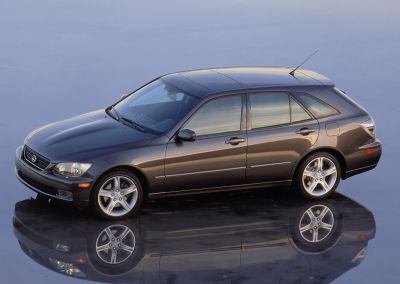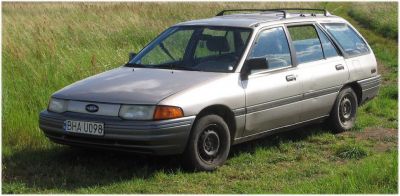 1988 Mercury Tracer Station Wagon Dimensions, Size & Specs
1988 Mercury Tracer Station Wagon Dimensions, Size & SpecsMeasurements of the 1988 Mercury Tracer Station Wagon, engineered for optimal performance and comfort
| Dimensions | |
|---|---|
| Length: | 4352-4390 mm171.3-172.8 in14.3-14.4 ft |
| Width: | 1700 mm66.9 in5.6 ft |
| Height: | 1361-1370 mm53.6-53.9 in4.5-4.5 ft |
| Trunk Capacity: | 865 liter30.5 cu ft |
| Weight Specifications | |
| Curb Weight: | 1120-1145 kg2469-2524 lbs |
| Tire Specifications | |
| Rims Size: |
|
| Tire Sizes: |
|
The Mercury Tracer Station Wagon, produced from 1988 to 2001, is a compact and practical station wagon that offers a balance between city driving convenience and family utility. This generation of the Tracer has a length ranging from 4352 mm to 4390 mm (171.3 to 172.8 inches), a width of 1695 to 1700 mm (66.7 to 66.9 inches), and a height between 1361 mm and 1370 mm (53.6 to 53.9 inches). These dimensions make it a maneuverable yet spacious option in the compact wagon segment. The curb weight falls between 1120 kg and 1145 kg (2470 to 2524 pounds), contributing to its fuel efficiency and agile handling. Inside, the Tracer Station Wagon boasts a generous luggage capacity of approximately 865 liters (30.5 cubic feet), which is advantageous for families or users needing extra cargo room. The standard rim size for this model is 14 inches, typically paired with tire sizes 175/65 R14 or 185/65 R14, ensuring a comfortable ride with reliable road handling. Overall, the Mercury Tracer Station Wagon is a sensible choice within its class, offering adequate interior space and efficient dimensions for everyday use and longer trips, positioning it well among other compact wagons of its era.
Discover the standout features that make the 1988 Mercury Tracer Station Wagon a leader in its class
Have a question? Please check our knowledgebase first.
The Mercury Tracer Station Wagon produced from 1988 to 2001 has exterior dimensions that vary slightly within its production span. Its length ranges from 4352 mm to 4390 mm (171.3 to 172.8 inches), its width is between 1695 mm and 1700 mm (66.7 to 66.9 inches), and its height measures from 1361 mm to 1370 mm (53.6 to 53.9 inches). These compact dimensions make the Tracer Station Wagon well-suited for urban driving while still providing the practical space expected of a station wagon.
The curb weight of the 1988 Mercury Tracer Station Wagon falls between 1120 kg and 1145 kg (2,469 to 2,524 pounds). This relatively light weight for a station wagon contributes to nimble handling and improved fuel efficiency, while still offering stability and comfort. The lighter curb weight also means that the vehicle can accelerate and brake effectively, making it a practical choice for both city commutes and longer drives.
The Mercury Tracer Station Wagon offers a generous luggage capacity of approximately 865 liters (30.5 cubic feet). This volume provides substantial storage space for luggage, groceries, sports equipment, or other cargo, making it a practical vehicle for families or individuals needing versatile space. The station wagon layout enhances utility by allowing a more expansive and easily accessible cargo area compared to sedans.
Yes, the Mercury Tracer Station Wagon's dimensions allow it to fit comfortably into a standard residential garage. The typical garage door width ranges from 2.4 meters to 2.7 meters (94.5 to 106.3 inches), and the Tracer’s maximum width is about 1700 mm (66.9 inches). Its length, up to approximately 4.39 meters (172.8 inches), is also compatible with most standard garage depths. Its relatively low height further ensures clearance inside most typical garages.
The 1988 Mercury Tracer Station Wagon was developed as part of a transition to a more compact and efficient vehicle platform. Compared to its predecessor, it generally features slightly reduced or similar exterior dimensions, emphasizing more streamlined and modern station wagon design. The focus was on maintaining interior space and utility while improving maneuverability. Its length and width allowed better city handling compared to larger, earlier station wagons, all while slightly improving fuel economy and load capacity.
The Mercury Tracer Station Wagon is comparable in size to other compact station wagons of its era, such as the Ford Escort Wagon and the Chevrolet Corsica Wagon. Its length of approximately 4.35 to 4.39 meters (171.3 to 172.8 inches) and width near 1.7 meters (66.9 inches) make it slightly smaller than some mid-size wagons but competitive within the compact segment. This balance offered practicality in cargo space and passenger comfort while maintaining ease of maneuverability in urban environments.
The Mercury Tracer Station Wagon comes equipped with 14-inch rims paired with tires sized either 175/65 R14 or 185/65 R14. These tire sizes provide a good balance between ride comfort, handling, and fuel efficiency. The relatively narrow and taller profile tires help absorb road imperfections and improve traction, which is ideal for the car's intended role as a family-friendly station wagon with reliable day-to-day performance.
The Mercury Tracer Station Wagon offers seating for five passengers, with two front bucket seats and a rear bench seat. The interior space is optimized for comfort within its compact dimensions. The station wagon design provides enhanced headroom and legroom compared to similar compact sedans of the era. The rear seats can typically be folded down to expand the cargo area, increasing versatility for transporting larger items or more luggage.
Starting with the 1988 model year, the Mercury Tracer Station Wagon was introduced as a practical, compact family vehicle with a focus on fuel efficiency, utility, and modern styling. Key updates included improved aerodynamics, a shift to front-wheel drive, and a design shared with Ford Escort variants, encouraging parts commonality and cost efficiency. The station wagon body style emphasized cargo capacity and passenger comfort, making it a versatile option for diverse driver needs.
Owners of the 1988 Mercury Tracer Station Wagon should focus on routine maintenance such as regular oil changes, brake inspections, and timely replacement of wear items like tires and belts to ensure longevity. Given its production span until 2001, the car generally features reliable engineering typical of late 1980s American compacts but may encounter age-related issues like suspension wear or corrosion in certain climates. Paying attention to cooling system maintenance and transmission fluid changes will also help preserve driving performance.
Discover similar sized cars.

| Production: | 2001-2005 |
|---|---|
| Model Year: | 2001 |
| Length: | 4400 mm173.2 in |
| Width: | 1725 mm67.9 in |
| Height: | 1412 mm55.6 in |

| Model Year: | 1991 |
|---|---|
| Length: | 4351-4387 mm171.3-172.7 in |
| Width: | 1694-1702 mm66.7-67.0 in |
| Height: | 1361-1369 mm53.6-53.9 in |
